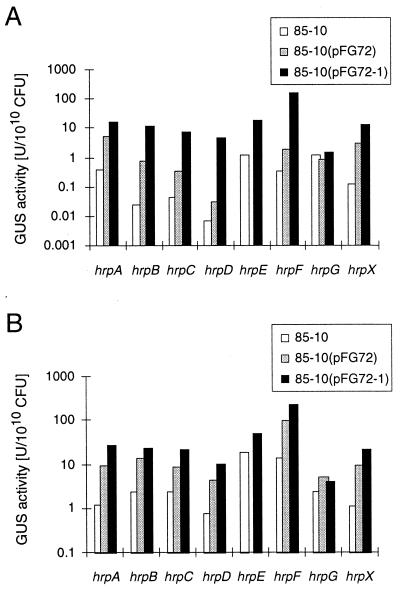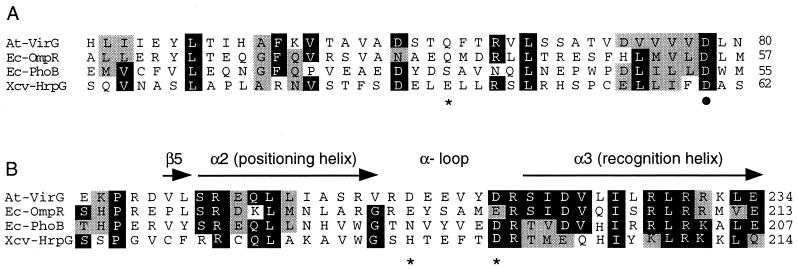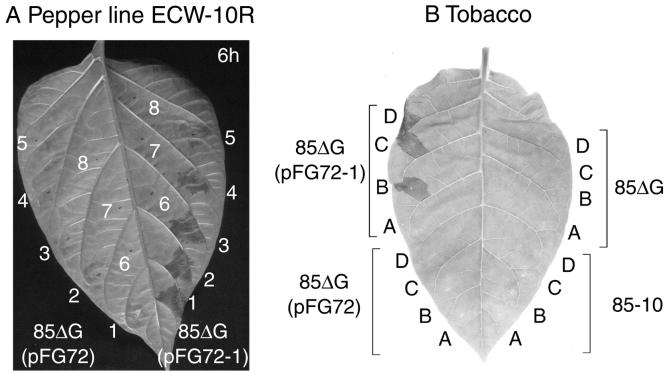Abstract
hrpG is a key regulatory gene for transcriptional activation of pathogenicity genes (hrp) of Xanthomonas campestris pv. vesicatoria. We identified three mutations in hrpG which render hrp gene expression constitutive in normally suppressing medium. The mutations in hrpG result in novel amino acid substitutions compared to mutations in related proteins, such as OmpR. In addition, mutated hrpG enhances the timing and intensity of plant reactions in infection assays.
The interaction of the gram-negative bacterium Xanthomonas campestris pv. vesicatoria (hereafter X. campestris) with its host plants pepper and tomato is controlled by hrp (hypersensitive reaction and pathogenicity) genes (3), some of which are predicted to encode components of a type III protein secretion system (1, 5). hrp gene expression is suppressed in complex medium (NYG [5 g of peptone, 3 g of yeast extract, and 20 g of glycerol per liter]), but is induced in planta and in the synthetic XVM2 medium (16, 19) and is regulated by two genes, hrpX and hrpG. hrpX encodes a protein of the AraC family and activates transcription of the operons hrpB to hrpF (18). Expression of hrpX and hrpA depends on hrpG, which encodes a putative response regulator protein of two-component signal transduction systems (20). The predicted HrpG protein is most similar to proteins of a subclass containing Escherichia coli OmpR (4, 22) and Agrobacterium tumefaciens VirG (21). The X. campestris hrpG gene is expressed at a low level in NYG medium but requires hrp gene-inducing conditions for the activation of downstream genes (20). To achieve hrp gene expression in noninducing media, we performed a random mutagenesis of hrpG and selected for mutations rendering expression of all hrp genes constitutive in NYG medium.
First, a suitable reporter plasmid, pPCspec, was constructed by fusing a 320-bp fragment encompassing the hrpG-regulated X. campestris hrpC promoter to a promoterless aadA gene in pLAFR6 (2). The aadA gene, which confers resistance to spectinomycin, was amplified by PCR from the omega cassette (14) by using oligonucleotides 161 (5′ GGGGAGCTCAAACAAAGTTAAACATC 3′) and 162 (5′ GGGGAATTCATTATTTGCCGACTACC 3′) (restriction sites used for cloning are underlined). For mutagenesis of hrpG, plasmid pFG72, which carries hrpG on a 1.7-kb BamHI-KpnI fragment in the low-copy plasmid pUFR043 (gift from D. Gabriel, University of Florida, Gainesville), was transformed into the E. coli mutator strain Epicurian Coli XL1-Red (Stratagene, La Jolla, Calif.). Plasmid DNA was isolated at different time points and transformed into E. coli DH5α. Transformants were conjugated en masse with X. campestris 85-10 (11) carrying pPCspec and plated on NYG agar containing 400 μg of spectinomycin per ml. Eleven spectinomycin-resistant transconjugants, obtained at a frequency of 10−4, were analyzed further. To test the effect of the mutated pFG72 derivatives on hrp promoter activity, they were first introduced into X. campestris 85-10 carrying pPC490, an hrpC promoter-uidA fusion in pL6GUSB (2). β-Glucuronidase (GUS) activities were determined after growth of bacteria in NYG and in hrp gene-inducing XVM2 medium. All 11 mutated hrpG plasmids (designated pFG72-1 to pFG72-11) activated the hrpC promoter in NYG. To determine the activity of all other known hrp promoters in presence of the mutated hrpG gene, pFG72-1 (hrpG herein referred to as hrpG*) was conjugated into X. campestris strains carrying hrp promoter-uidA fusion plasmids pPA2, pPB1, pPD3, pPFI42, pPG1, and pPX2 (2, 6, 18–20), which express the uidA gene under the control of the hrpA, hrpB, hrpD, hrpF, hrpG, and hrpX promoters, respectively. hrpE promoter activity was determined by using pXV4::E525 (18). As shown in Fig. 1A, additional copies of the wild-type hrpG plasmid pFG72 resulted in somewhat higher GUS activities of bacteria grown in NYG medium compared to 85-10. However, in the presence of hrpG*, all hrp promoters, except for the hrpG promoter, exhibited 20- to 1,000-fold higher activities in NYG compared to wild-type strain 85-10. In XVM2 medium, GUS activities in the presence of hrpG* were in the same order of magnitude as those with additional copies of the wild-type gene and were 10-fold higher than those for strains containing only the genomic copy (Fig. 1B).
FIG. 1.
Activity of X. campestris hrp promoters in the presence of wild-type hrpG and hrpG*. Wild-type strain 85-10 carrying plasmid-borne transcriptional hrp promoter-uidA fusions and no additional hrpG, plasmid-borne hrpG (pFG72), and hrpG* (pFG72-1), respectively, were grown for 16 h in NYG (A) and XVM2 (B). For technical reasons, hrpE promoter activity was determined with hrpG* expressed in pDSK600. GUS assays were performed as described previously (16). Specific GUS activities are the average of two experiments and are graphically displayed with a logarithmic scale (1 U = 1 nmol of 4-methyl-umbelliferyl-β-d-glucuronide released per bacterium per min).
DNA sequencing of hrpG* in pFG72-1 revealed a single G-to-A mutation at position 130 of the hrpG coding sequence, leading to an E44K exchange in the translation product. Since this mutation destroys a SacI restriction site, the remaining 10 pFG72 derivatives were tested for presence or absence of this site. While eight of them had lost the SacI site and probably carry the same mutation as pFG72-1, the SacI site was present in two plasmids, pFG72-2 and pFG72-3. Sequence analysis revealed a G-to-A exchange at position 595 of hrpG in pFG72-2, leading to a D199N substitution, and an A-to-G mutation at position 581 in pFG72-3, resulting in an H194R exchange. All three hrpG mutations had identical effects on the activity of the hrpG-dependent promoters (data not shown).
Only a few known mutations in OmpR-type transcriptional activators render the protein constitutively active. These mutations have all been mapped to the N-terminal domain of a given protein (Table 1 and Fig. 2). For example, in the Agrobacterium irG protein, N54E or I106L substitutions (N80 or I132 in Fig. 2) resulted in constitutive vir gene expression (12). A D55E substitution in the E. coli OmpR protein rendered it active independent of the sensor kinase EnvZ (8). Whether the E44K mutation in the N-terminal domain of HrpG mimics the predicted phosphorylation of the D60 residue in HrpG (20) is a matter of speculation. Interestingly, the other two mutations in X. campestris HrpG identified here, H194R and D199N, are located in the C-terminal domain of the protein. In contrast to HrpG, substitutions at corresponding positions in E. coli OmpR (E193K and E198K) and PhoB (D192G) led to loss of function (9, 13, 15). It has been shown for OmpR that the region from amino acid 192 to amino acid 199 forms a loop exposed at the protein surface, which has been proposed to control RNA polymerase activity by direct interaction with its α-subunit (10). The H194R and D199N substitutions in HrpG might, therefore, lead to transcriptional activation due to alteration of contact with RNA polymerase.
TABLE 1.
Amino acid substitutions in HrpG and selected homologous proteins and their phenotypic effect
| Protein | Mutation | Phenotypea | Effect | Reference |
|---|---|---|---|---|
| HrpG | E44K | + | hrp gene expression in complex medium | This study |
| OmpR | R42H | − | Defective for transcription activation of ompC | 13 |
| OmpR | R42C | − | Defective for transcription activation of ompC | 13 |
| OmpR | L43R | + | Increased curli expression | 17 |
| OmpR | D55E | + | Sensor kinase-independent activity | 8 |
| VirG | N54D | + | vir gene expression in the absence of the inducer | 12 |
| VirG | I106L | + | vir gene expression in the absence of the inducer | 12 |
| HrpG | H194R | + | hrp gene expression in complex medium | This study |
| HrpG | D199N | + | hrp gene expression in complex medium | This study |
| OmpR | E193K | − | Defective for transcription activation of ompC and ompF | 15 |
| OmpR | A196V | − | Defective for transcription activation of ompC | 13 |
| OmpR | E198K | − | Defective for transcription activation of ompC | 13;) |
| PhoB | V190M | − | Defective for interaction with RNA polymerase | 9 |
| PhoB | D192G | − | Defective for interaction with RNA polymerase | 9 |
| PhoB | D192N | − | Defective for transcription activation of phoA | 9 |
+ and − refer to constitutively active and loss-of-function phenotypes, respectively.
FIG. 2.
Protein sequence alignment of X. campestris HrpG and selected homologs. (A) Only the relevant region in the N terminus of proteins is shown. Highly conserved amino acids are boxed in black. At, A. tumefaciens; Ec, E. coli; Xcv, X. campestris pv. vesicatoria. (B) Only the relevant part of the C-terminal region of proteins is shown. Structural and functional elements are indicated above the sequence. The positions of β-sheets, recognition helices, and α-loops are based on structural data for OmpR (10). The asterisks mark the positions of three independent substitutions in HrpG; the dot indicates the position of the conserved aspartate residue, which is predicted to be phosphorylated (10). Database accession numbers: A. tumefaciens VirG, SWISS-PROT P06664; E. coli OmpR, SWISS-PROT P03025; E. coli PhoB, SWISS-PROT P08402; X. campestris pv. vesicatoria HrpG, GENBANK U57625.
Because hrpG is a key regulator for the interaction of X. campestris with plants, we wondered whether the three mutations in hrpG alter the plant reaction after infection. To avoid interference of mutated hrpG with the wild-type gene, a 950-bp SacI fragment spanning most of the hrpG coding region was deleted. The mutation was introduced into the chromosome of X. campestris wild-type strain 85-10 using suicide plasmid pOK1 (7), resulting in mutant 85ΔG. Transconjugants of 85ΔG harboring pFG72, pFG72-1, pFG72-2, or pFG72-3 were inoculated into leaves of susceptible (ECW) and resistant (ECW-10R) pepper plants (11). Symptoms caused by wild-type and mutated hrpG bacteria in ECW were indistinguishable. On pepper ECW-10R, strain 85-10 induces the hypersensitive reaction (HR), a rapid, localized cell death reaction, approximately 8 to 10 h after inoculation. Bacteria expressing hrpG* induced a complete, confluent collapse (earliest macroscopically visible reaction) on ECW-10R as soon as 4 h after inoculation (Fig. 3A). No difference was observed between hrpG* and mutated hrpG present in pFG72-2 and pFG72-3. The minimal concentration of hrpG* bacteria needed to induce the HR on ECW-10R was two- to fourfold lower than those for 85-10 and 85ΔG(pFG72). Thus, hrpG* enhances the HR induction with respect to both time and efficiency. We then tested whether a stronger HR was also observed in the nonhost plant tobacco, which is resistant to X. campestris. Different densities of bacterial suspensions were inoculated into leaves of Nicotiana tabaci cv. Xanthi plants (Fig. 3B). Inoculation of the hrpG* strain induced a confluent HR 1 day after inoculation. In contrast, strains 85ΔG(pFG72) and 85-10 induced only a weak chlorotic and necrotic reaction 2 to 3 days after infection.
FIG. 3.
Effect of hrpG* on HR induction on resistant plants. (A) HR induction on pepper line ECW-10R after inoculation with 85ΔG(pFG72) and 85ΔG(pFG72-1). Bacteria were grown overnight on NYG agar and resuspended in H2O. Serial twofold dilutions of bacterial suspensions, from 5 × 108 to 4 × 106 CFU/ml (no. 1 to 8), were infiltrated into the intercellular space of a fully expanded leaf of an 8-week-old plant. The photograph of the underside of the leaf was taken 6 h after inoculation. (B) Reaction of Nicotiana tabacum cv. Xanthi after inoculation with different X. campestris strains. Strains 85-10, 85ΔG, 85ΔG(pFG72), and 85ΔG(pFG72-1) were inoculated at bacterial densities of 2 × 107 (A), 2 × 108 (B), 8 × 108 (C), and 2 × 109 (D) CFU/ml. The photograph was taken 24 h after inoculation.
To reexamine the effect of hrpG* on susceptible plants in a bacterial genetic background resembling the natural situation, the wild-type copy was replaced by hrpG* in strains 85-10 and 82-8 (11) with pOK1 (7) to generate 85* and 82*. Chromosomal hrpG* accelerated the HR induction, as described above for hrpG* expressed from a plasmid. However, there was a clear difference in timing and intensity of disease symptoms on the susceptible plant, ECW. Water-soaked lesions, typical early disease symptoms, appeared much earlier (49 h) and were stronger than with the wild-type strains (65 to 72 h). These effects were not due to increased bacterial growth in the presence of hrpG*, as determined by bacterial growth curves in planta (data not shown).
In conclusion, we identified three mutations in the key hrp regulatory gene hrpG rendering expression of downstream genes constitutive. The mutations residing in the C-terminal domain of HrpG are particularly interesting, because similar mutations in homologous proteins lead to inactivation. The amplifying effect of mutated hrpG on both disease symptoms and cell death is intriguing and might be indicative of more efficient Hrp type III protein delivery into the plant tissue.
Acknowledgments
We thank R. Koebnik for helpful suggestions for the manuscript.
This study was in part funded by an EC grant (BIO4-CT97-2244) to U.B. K.W. and O.R. were supported by the Human Capital and Mobility program of the European Union and by a grant from the Ministère de l’Education Nationale et de la Recherche, respectively.
REFERENCES
- 1.Bogdanove A, Beer S V, Bonas U, Boucher C A, Collmer A, Coplin D L, Cornelis G R, Huang H-C, Hutcheson S W, Panopoulos N J, Van Gijsegem F. Unified nomenclature for broadly conserved hrp genes of phytopathogenic bacteria. Mol Microbiol. 1996;20:681–683. doi: 10.1046/j.1365-2958.1996.5731077.x. [DOI] [PubMed] [Google Scholar]
- 2.Bonas, U. Unpublished data.
- 3.Bonas U, Schulte R, Fenselau S, Minsavage G V, Staskawicz B J. Isolation of a gene cluster from Xanthomonas campestris pv. vesicatoria that determines pathogenicity and the hypersensitive response on pepper and tomato. Mol Plant-Microbe Interact. 1991;4:81–88. [Google Scholar]
- 4.Comeau D E, Ikenaka K, Tsung K, Inouye M. Primary characterization of the protein products of the Escherichia coli ompB locus: structure and regulation of synthesis of the OmpR and EnvZ proteins. J Bacteriol. 1985;164:578–584. doi: 10.1128/jb.164.2.578-584.1985. [DOI] [PMC free article] [PubMed] [Google Scholar]
- 5.Fenselau S, Balbo I, Bonas U. Determinants of pathogenicity in Xanthomonas campestris pv. vesicatoria are related to proteins involved in secretion in bacterial pathogens of animals. Mol Plant-Microbe Interact. 1992;5:390–396. doi: 10.1094/mpmi-5-390. [DOI] [PubMed] [Google Scholar]
- 6.Fenselau S, Bonas U. Sequence and expression analysis of the hrpB pathogenicity operon of Xanthomonas campestris pv. vesicatoria which encodes eight proteins with similarity to components of the Hrp, Ysc, Spa, and Fli secretion systems. Mol Plant-Microbe Interact. 1995;8:845–854. doi: 10.1094/mpmi-8-0845. [DOI] [PubMed] [Google Scholar]
- 7.Huguet E, Hahn K, Wengelnik K, Bonas U. hpaA mutants of Xanthomonas campestris pv. vesicatoria are affected in pathogenicity but retain the ability to induce host-specific hypersensitive reaction. Mol Microbiol. 1998;29:1379–1390. doi: 10.1046/j.1365-2958.1998.01019.x. [DOI] [PubMed] [Google Scholar]
- 8.Lan C-Y, Igo M M. Differential expression of the OmpF and OmpC porin proteins in Escherichia coli K-12 depends upon the level of active OmpR. J Bacteriol. 1998;180:171–174. doi: 10.1128/jb.180.1.171-174.1998. [DOI] [PMC free article] [PubMed] [Google Scholar]
- 9.Makino K, Amemura M, Kawamoto T, Kimura S, Shinagawa H, Nakata A, Suzuki M. DNA binding of PhoB and its interaction with RNA polymerase. J Mol Biol. 1996;259:15–26. doi: 10.1006/jmbi.1996.0298. [DOI] [PubMed] [Google Scholar]
- 10.Martinez-Hackert E, Stock A M. Structural relationships in the OmpR family of winged-helix transcription factors. J Mol Biol. 1997;239:301–312. doi: 10.1006/jmbi.1997.1065. [DOI] [PubMed] [Google Scholar]
- 11.Minsavage G V, Dahlbeck D, Whalen M C, Kearney B, Bonas U, Staskawicz B J, Stall R E. Gene-for-gene relationships specifying disease resistance in Xanthomonas campestris pv. vesicatoria-pepper interactions. Mol Plant-Microbe Interact. 1990;3:41–47. [Google Scholar]
- 12.Pazour G J, Ta C N, Das A. Constitutive mutations of Agrobacterium tumefaciens transcriptional activator virG. J Bacteriol. 1992;174:4169–4174. doi: 10.1128/jb.174.12.4169-4174.1992. [DOI] [PMC free article] [PubMed] [Google Scholar]
- 13.Pratt L A, Silhavy T J. OmpR mutants specifically defective for transcriptional activation. J Mol Biol. 1994;243:579–594. doi: 10.1016/0022-2836(94)90033-7. [DOI] [PubMed] [Google Scholar]
- 14.Prentki P, Krisch H M. In vitro insertion mutagenesis with a selectable DNA fragment. Gene. 1984;29:303–313. doi: 10.1016/0378-1119(84)90059-3. [DOI] [PubMed] [Google Scholar]
- 15.Russo F D, Slauch J M, Silhavy T J. Mutations that affect separate functions of OmpR the phosphorylated regulator of porin transcription in Escherichia coli. J Mol Biol. 1993;231:261–273. doi: 10.1006/jmbi.1993.1281. [DOI] [PubMed] [Google Scholar]
- 16.Schulte R, Bonas U. Expression of the Xanthomonas campestris pv. vesicatoria hrp gene cluster, which determines pathogenicity and hypersensitivity on pepper and tomato, is plant inducible. J Bacteriol. 1992;174:815–823. doi: 10.1128/jb.174.3.815-823.1992. [DOI] [PMC free article] [PubMed] [Google Scholar]
- 17.Vidal O, Longin R, Prigent-Combaret C, Dorel C, Hooreman M, Lejeune P. Isolation of an Escherichia coli K-12 mutant strain able to form biofilms on inert surfaces: involvement of a new ompR allele that increases curli expression. J Bacteriol. 1998;180:2442–2449. doi: 10.1128/jb.180.9.2442-2449.1998. [DOI] [PMC free article] [PubMed] [Google Scholar]
- 18.Wengelnik K, Bonas U. HrpXv, an AraC-type regulator, activates expression of five out of six loci in the hrp cluster of Xanthomonas campestris pv. vesicatoria. J Bacteriol. 1996;178:3462–3469. doi: 10.1128/jb.178.12.3462-3469.1996. [DOI] [PMC free article] [PubMed] [Google Scholar]
- 19.Wengelnik K, Marie C, Russel M, Bonas U. Expression and localization of HrpA1, a protein of Xanthomonas campestris pv. vesicatoria essential for pathogenicity and induction of the hypersensitive reaction. J Bacteriol. 1996;178:1061–1069. doi: 10.1128/jb.178.4.1061-1069.1996. [DOI] [PMC free article] [PubMed] [Google Scholar]
- 20.Wengelnik K, Van den Ackerveken G, Bonas U. HrpG, a key hrp regulatory protein of Xanthomonas campestris pv. vesicatoria is homologous to two-component response regulators. Mol Plant-Microbe Interact. 1996;9:704–712. doi: 10.1094/mpmi-9-0704. [DOI] [PubMed] [Google Scholar]
- 21.Winans S C, Ebert P R, Stachel S E, Gordon M P, Nester E W. A gene essential for Agrobacterium virulence is homologous to a family of positive regulatory loci. Proc Natl Acad Sci USA. 1986;83:8278–8282. doi: 10.1073/pnas.83.21.8278. [DOI] [PMC free article] [PubMed] [Google Scholar]
- 22.Wurtzel E T, Chou M Y, Inouye M. Osmoregulation of gene expression. I. DNA sequence of the ompR gene of the ompB operon of Escherichia coli and characterization of its gene product. J Biol Chem. 1982;257:13685–13691. [PubMed] [Google Scholar]





